- WE MOVED !!!
-
 Professional Acupuncture & Physical Therapy1118 East Superior Street
Professional Acupuncture & Physical Therapy1118 East Superior Street
Duluth, MN 55802(218) 724-3400 Clinic Hours
Mon8:00 am - 4:30 pmTue1:45 pm - 4:30 pmWed8:00 am - 4:30 pmThu8:00 am - 4:30 pmFriCLOSED
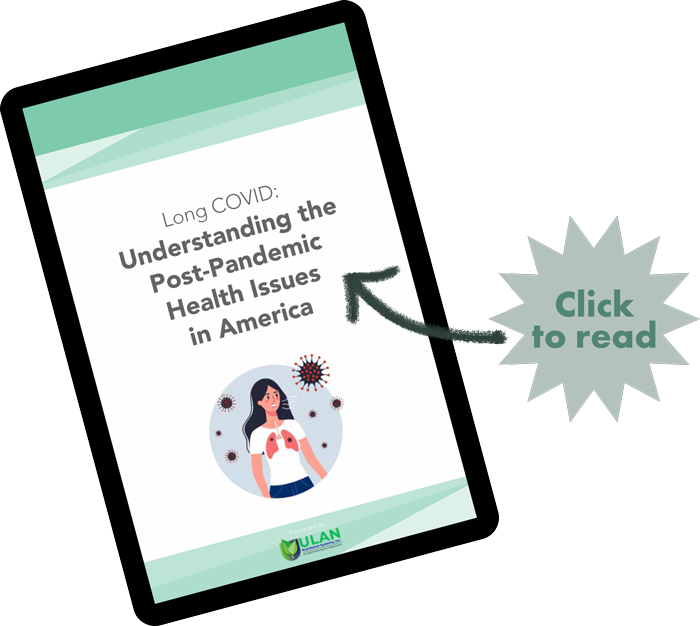
- Long Covid Booklet
Traditional Chinese Medicine
Why Do We Ask About Your Poop?
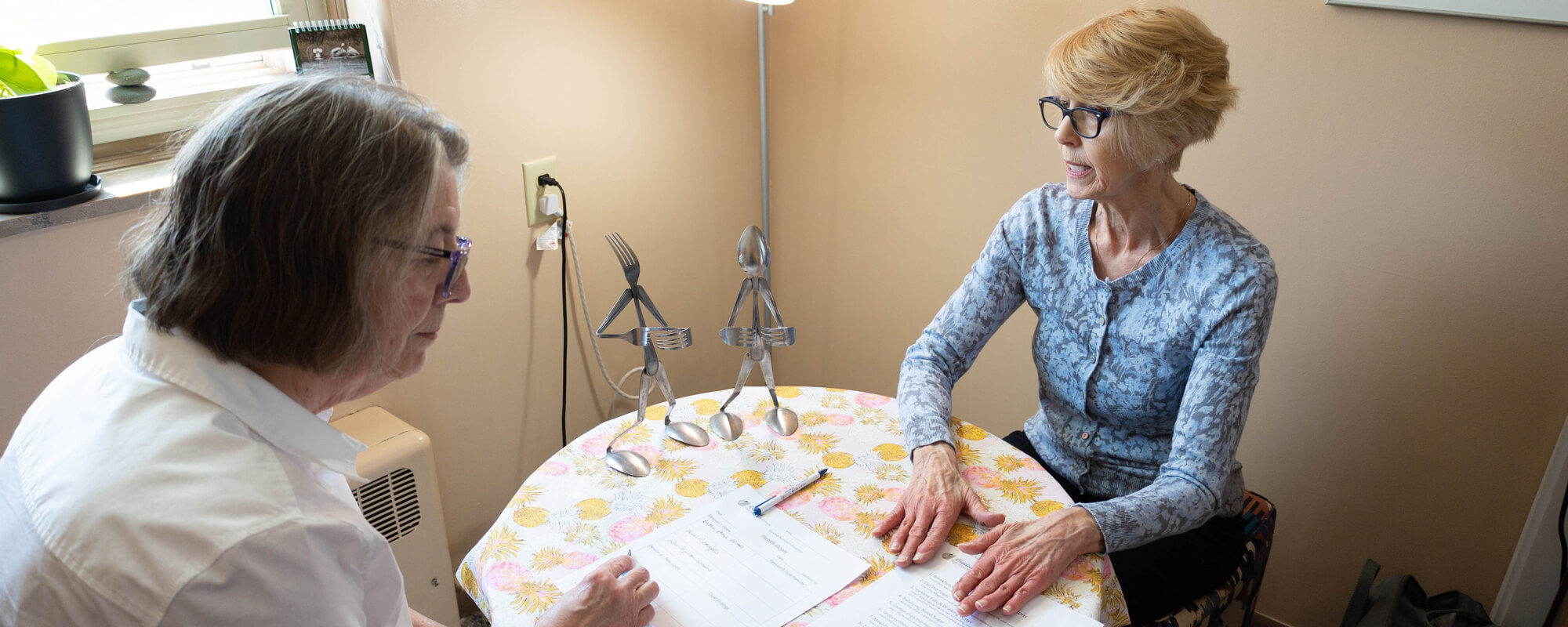 If it’s your first time seeing an acupuncturist you may be taken back by some of the questions you are asked during the intake. Even if you are just coming in for help with headaches, you’d most likely get questioned about seemingly unrelated bodily functions. While the subject of your poop may be uncomfortable at first, rest assured that, in Chinese Medicine, it has a long history of being used as an important diagnostic tool. In the case of the headache and almost any other complaint, the color, consistency, frequency, even odor of your poop can point to patterns in energy, substance and organ relationships that will inform the most effective treatment.
If it’s your first time seeing an acupuncturist you may be taken back by some of the questions you are asked during the intake. Even if you are just coming in for help with headaches, you’d most likely get questioned about seemingly unrelated bodily functions. While the subject of your poop may be uncomfortable at first, rest assured that, in Chinese Medicine, it has a long history of being used as an important diagnostic tool. In the case of the headache and almost any other complaint, the color, consistency, frequency, even odor of your poop can point to patterns in energy, substance and organ relationships that will inform the most effective treatment.
While your acupuncturist is investigating the imbalance that is responsible for whatever you are seeking treatment for, you will get asked specific questions about what ends up in your porcelain throne. The reason for this is because many organs are involved in the process of digestion. We often look at the absorptive functions of the spleen, stomach and small intestine, the Kidneys as the root source of digestive fire, the liver as an important player in harmonizing digestive function through the regulation of qi movement in the body and the large intestine as that main exit pathway that pulls out excess water to finally concentrate our waste material into the perfect poop.
In explaining the state of the body based on the function of these organs, Chinese Medicine uses terms like damp, dry, heat, cold, stagnant, excess, and deficient. These terms refer to patterns of energy and substance recognized in the body that can predict other health aspects. For example, we can predict that a patient recognized as having a “damp pattern” evidenced in loose stools and edema might tend to also suffer from brain fog and difficulty losing weight.
So before getting into the various signs of imbalance, let’s lay out the ideal poop situation. When all is well a person should have a bowel movement 1-2x/day. Less can be considered constipation, while more would be considered diarrhea. According to TCM (Traditional Chinese Medicine), the perfect bowel movement is formed but not hard, it should not be odorous, there should be no blood or pus, and you should not have to push hard. If you fit the bill, this is generally indicative of not only good digestive health, but overall health as well.
Signs of imbalance include stool that is too soft, too dry, sticky, thin, small, stinky or any color other than a nice dark brown.
Soft or loose with undigested food: we look at spleen, stomach and small intestine absorptive function as well as the strength of the kidney yang or that fire of metabolism in the body.
Dry, hard: generally considered to be caused by a deficiency of yin (moisturizing, cooling aspects of the body), or blood. Basically, the person is dehydrated.
Thin: can be a result of qi deficiency or qi stagnation. Consistently pencil thin stools are considered a red flag in Western medicine, and while it may just be an area of spasm in the colon, it is best to rule out more serious concerns like a blockage such as a tumor.
Sticky or Slimy: If you have to wipe multiple times, you may have excess ‘dampness’ or ‘phlegm’ in the body. (In Western medicine this is associated with the inability to break down fat).
Pebbles: If you tell your acupuncturists that your poop looks like goat droppings, s/he will check for signs of liver function. The liver, according to TCM, is in charge of keeping a smooth flow of qi in the body. If qi becomes stagnant, waste wont move along its exit path, instead it sits and dries up, breaking down into ‘pebbles’, especially when there is also excess heat involved.
Color is important from both an Eastern and western perspective. In either case, there are some red flags such as pale or gray stools which may indicate a bile blockage. Red in your stool can be indicative of blood (are you SURE you didn’t eat beets yesterday?!) which should be further investigated. Generally though, according to TCM, we may look for signs of heat (or infection) in the intestines if we hear that there is dark yellow stools, or want to check liver function if they tend more greenish.
Strong odor is another sign of heat in the intestines, While an especially foul odor indicates damp-heat. All of these distinctions are important as they inform treatment in both acupuncture and herbal approaches.
Even if you’re not experiencing any problems, it’s still a good idea to monitor your stool regularly. This can help you identify any potential health concerns before they become a bigger problem. So keep track of what your poop looks like, and if you notice any changes, talk to Heidi right away.
Kitchen Remedies for Radiant Skin: Unlocking the Power of Natural Ingredients
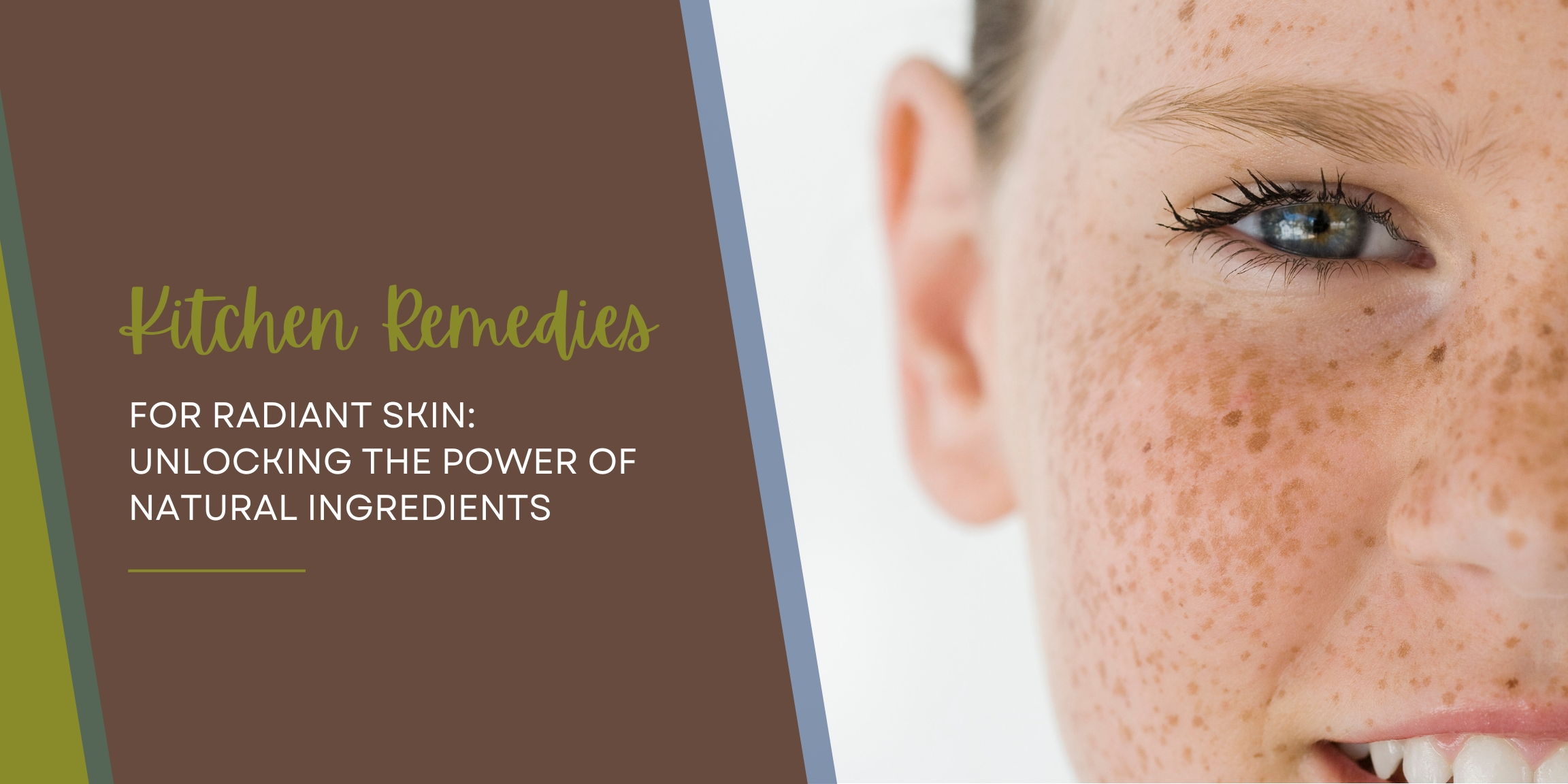
When it comes to achieving healthy and radiant skin, sometimes the best solutions can be found right in your kitchen. Nature has provided us with an array of powerful ingredients that can nourish and rejuvenate our skin. By incorporating kitchen remedies into your skincare routine, you can harness the power of natural ingredients to promote a glowing complexion. Let’s explore some easy and effective kitchen remedies for skin health.
1. Honey for Hydration:
Honey is a true skincare gem with its moisturizing and antibacterial properties. It helps to retain moisture, leaving your skin soft and supple. Apply a thin layer of raw honey to your face and let it sit for 10-15 minutes before rinsing with warm water. The natural enzymes in honey also gently exfoliate, revealing a refreshed complexion.
2. Turmeric for Brightening:
Turmeric has been used for centuries for its skin-brightening properties. Its active compound, curcumin, helps to reduce inflammation and even out skin tone. Mix a teaspoon of turmeric powder with plain yogurt or honey to form a paste. Apply it to your face and leave it on for 15-20 minutes before rinsing off. Be cautious, as turmeric can temporarily stain the skin, but it will fade over time.
3. Oatmeal for Soothing:
Oatmeal is a gentle and soothing ingredient that can calm irritated and sensitive skin. Grind a handful of oats into a fine powder and mix it with warm water to form a paste. Apply the mixture to your face and leave it on for 10-15 minutes. Rinse off gently with water, and enjoy the calming effect on your skin.
4. Lemon for Brightening and Exfoliation:
Lemon is a natural exfoliant and skin brightener, thanks to its high vitamin C content. Squeeze fresh lemon juice into a bowl and dilute it with equal parts water. Using a cotton ball, apply the mixture to your face and leave it on for 10 minutes before rinsing off. Due to its acidic nature, lemon juice can be drying, so it’s important to moisturize afterward and avoid sun exposure.
5. Avocado for Nourishment:
Avocado is a treasure trove of nutrients that can deeply nourish and hydrate the skin. Mash half an avocado and mix it with a tablespoon of honey or plain yogurt. Apply the mixture to your face and leave it on for 15-20 minutes before rinsing off. The natural oils in avocado will leave your skin feeling soft, supple, and rejuvenated.
Remember, everyone’s skin is unique, so it’s important to patch test any new ingredients to ensure compatibility with your skin. Additionally, these kitchen remedies can complement your regular skincare routine but should not replace professional dermatological advice for specific skin conditions.
Incorporating kitchen remedies into your skincare regimen can be an enjoyable and cost-effective way to nourish your skin naturally. So, raid your pantry and indulge in these wonderful kitchen remedies for radiant and healthy skin.
Note: If you have known allergies or skin sensitivities, it is crucial to consult with a dermatologist or healthcare professional before trying new ingredients on your skin.
Acupuncture and Psoriasis: A Natural Approach to Soothing Skin
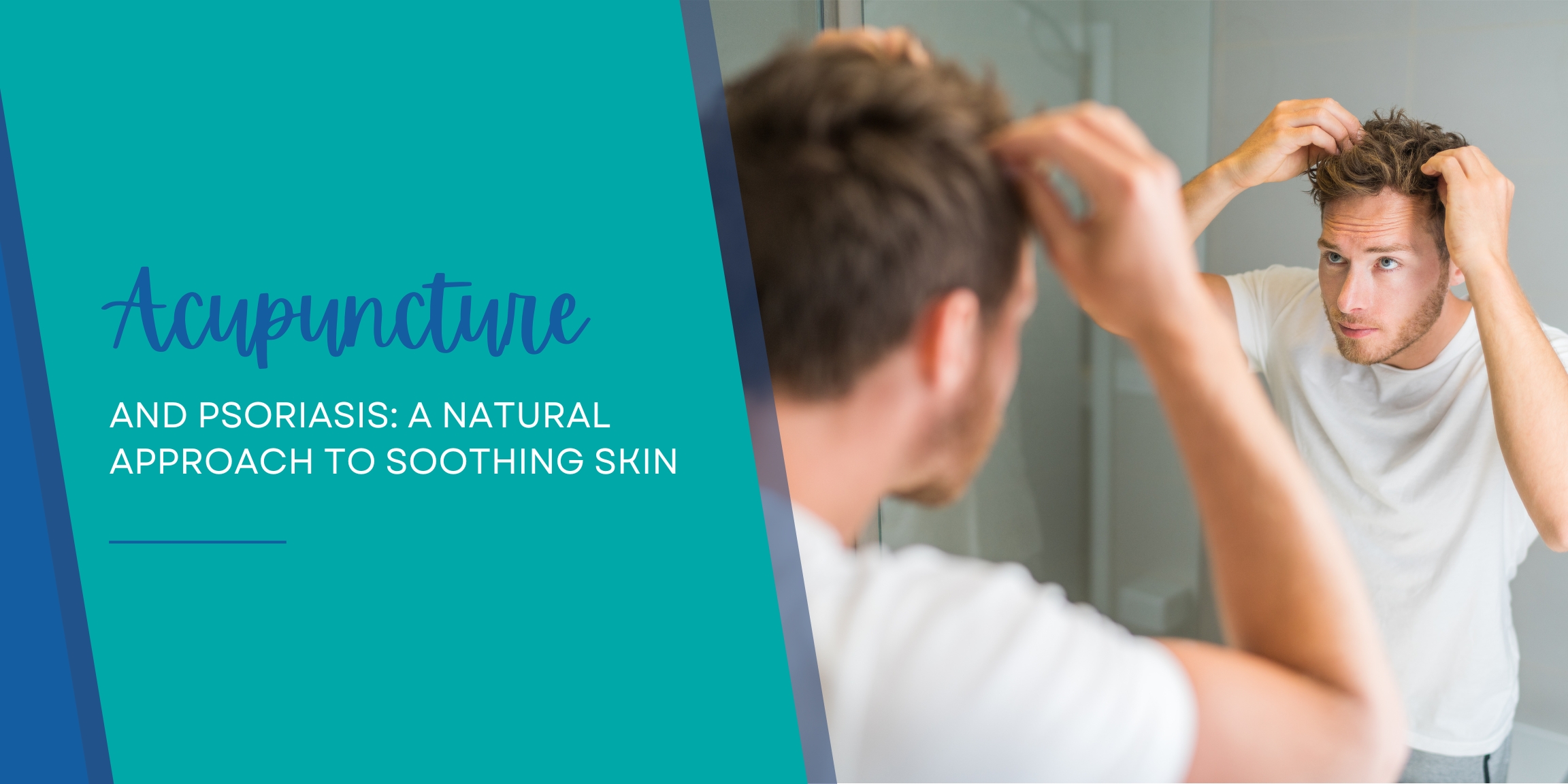
Living with psoriasis can be a challenging journey, as this chronic skin condition can cause discomfort and affect our overall well-being. While there is no cure for psoriasis, acupuncture offers a holistic and natural approach to managing its symptoms. In this article, we will explore how acupuncture can help soothe psoriasis and enhance skin health.
Understanding Psoriasis:
Psoriasis is an autoimmune condition that manifests as red, scaly patches on the skin. It occurs when the immune system triggers an overproduction of skin cells, leading to their rapid accumulation on the surface. This results in the characteristic plaques and itching commonly associated with psoriasis.
The Role of Acupuncture in Psoriasis Management:
Acupuncture, a key component of traditional Chinese medicine, focuses on restoring balance and promoting the body’s natural healing abilities. By targeting specific acupuncture points, acupuncture aims to regulate the flow of energy, known as Qi, within the body. Here’s how acupuncture can help manage psoriasis:
1. Reducing Inflammation:
Acupuncture has been found to possess anti-inflammatory properties, making it valuable in alleviating psoriasis-related inflammation. By stimulating acupuncture points, this ancient practice can help regulate immune responses and reduce the release of pro-inflammatory substances, providing relief for inflamed skin.
2. Promoting Circulation:
Psoriasis is associated with impaired blood circulation in affected areas. Acupuncture stimulates blood flow to the skin, promoting better circulation and oxygenation. Improved circulation supports the delivery of essential nutrients and removal of waste products, aiding in the healing process.
3. Regulating the Immune System:
Psoriasis is an immune system disorder, and acupuncture can help modulate immune responses. Research suggests that acupuncture can regulate immune function, preventing excessive immune activity that contributes to psoriasis symptoms. By promoting immune balance, acupuncture can help reduce the severity and frequency of psoriasis flare-ups.
4. Relieving Itch and Discomfort:
Persistent itching and discomfort are common challenges for individuals with psoriasis. Acupuncture can help alleviate itching by stimulating the release of endorphins, the body’s natural pain-relieving and mood-enhancing chemicals. By reducing itchiness and discomfort, acupuncture improves overall quality of life for those living with psoriasis.
Complementary Lifestyle Practices:
In addition to acupuncture, adopting healthy lifestyle practices can support psoriasis management. Consider incorporating the following habits into your routine:
1. Moisturize Regularly:
Keeping your skin hydrated is crucial for psoriasis management. Apply moisturizers daily to prevent dryness and minimize skin irritation. Look for fragrance-free and gentle moisturizers recommended by dermatologists or your healthcare provider.
2. Manage Stress:
Stress can trigger psoriasis flare-ups, so finding healthy ways to manage stress is essential. Engage in activities that promote relaxation, such as yoga, meditation, deep breathing exercises, or mindfulness practices. Acupuncture sessions can also help reduce stress levels.
3. Avoid Triggers:
Identify and avoid triggers that worsen your psoriasis symptoms. Common triggers include certain foods, alcohol, smoking, and excessive sun exposure. Keep a journal to track any patterns between your lifestyle choices and flare-ups, helping you make informed decisions about potential triggers to avoid.
4. Maintain a Balanced Diet:
While diet alone cannot cure psoriasis, consuming a balanced diet rich in fruits, vegetables, whole grains, lean proteins, and healthy fats can support overall skin health. Consider consulting with a registered dietitian or healthcare provider for personalized dietary recommendations.
Acupuncture offers a promising avenue for managing psoriasis symptoms naturally. By targeting the underlying imbalances within the body, acupuncture helps reduce inflammation, regulate the immune system, promote circulation, and provide relief from itchiness and discomfort. Alongside acupuncture, adopting a holistic approach that includes self-care practices and healthy lifestyle habits can further support your psoriasis management efforts.
Together, we can develop a comprehensive plan that supports your journey towards soothing skin and improved quality of life. Call Heidi at (218) 724-3400 to schedule an appointment today.
Helpsheet – Eye Safety
“The eyes are the window to the soul” as the saying goes.
This couldn’t be held more true in Traditional Chinese Medical theory as we look to the eyes to diagnose the quality of the shen, or spirit. Clear, bright eyes tell us the spirit is vital and strong, whereas dull eyes that lack spark suggest emotional struggles. Our eyes provide us a unique perspective into various aspects of health such as our emotional states, digestive function, and sleep quality. Keeping those soul windows sparkling requires a lifetime of maintenance.
Check out our helpsheet on eye safety below!
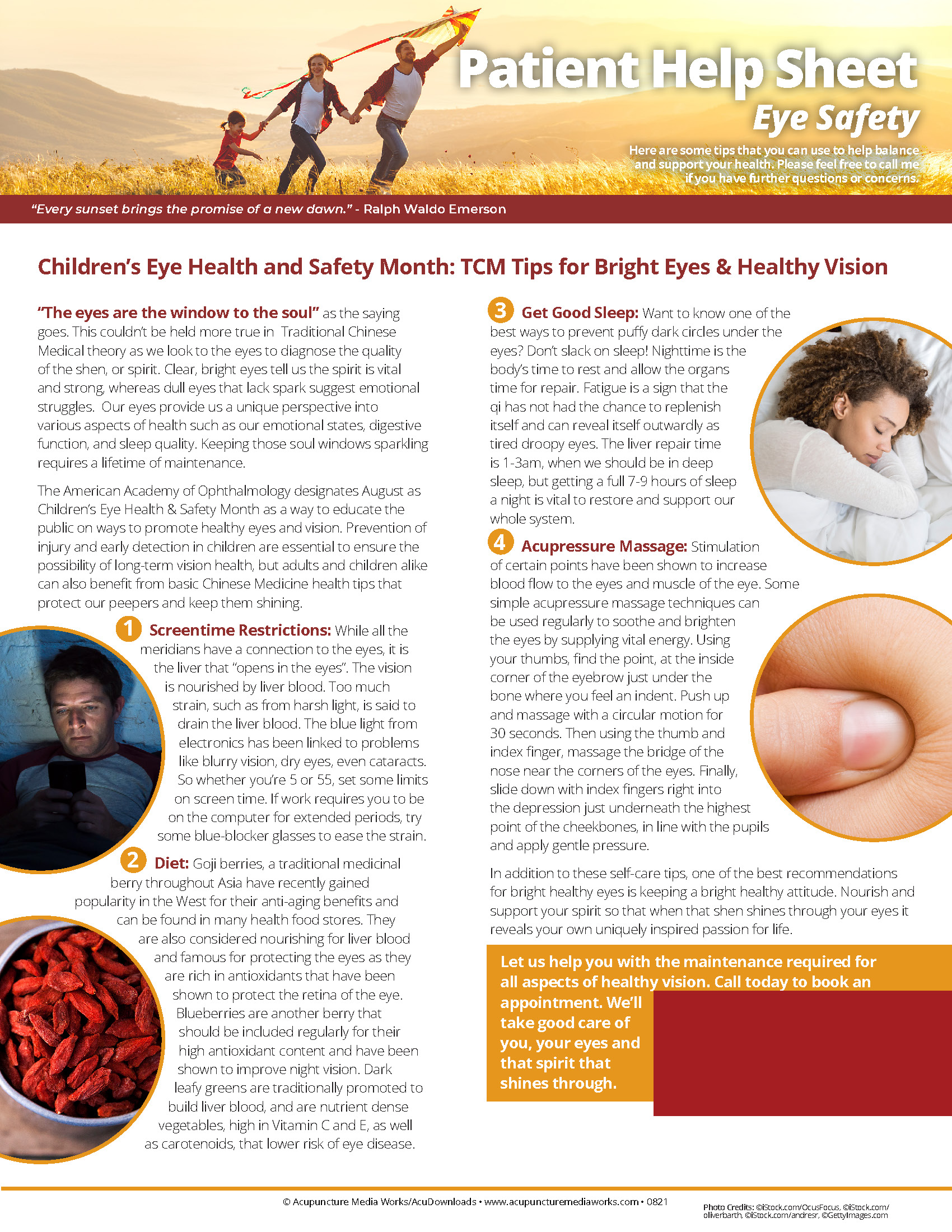
Acupuncture – the original bio-hack for Seasonal Allergies!
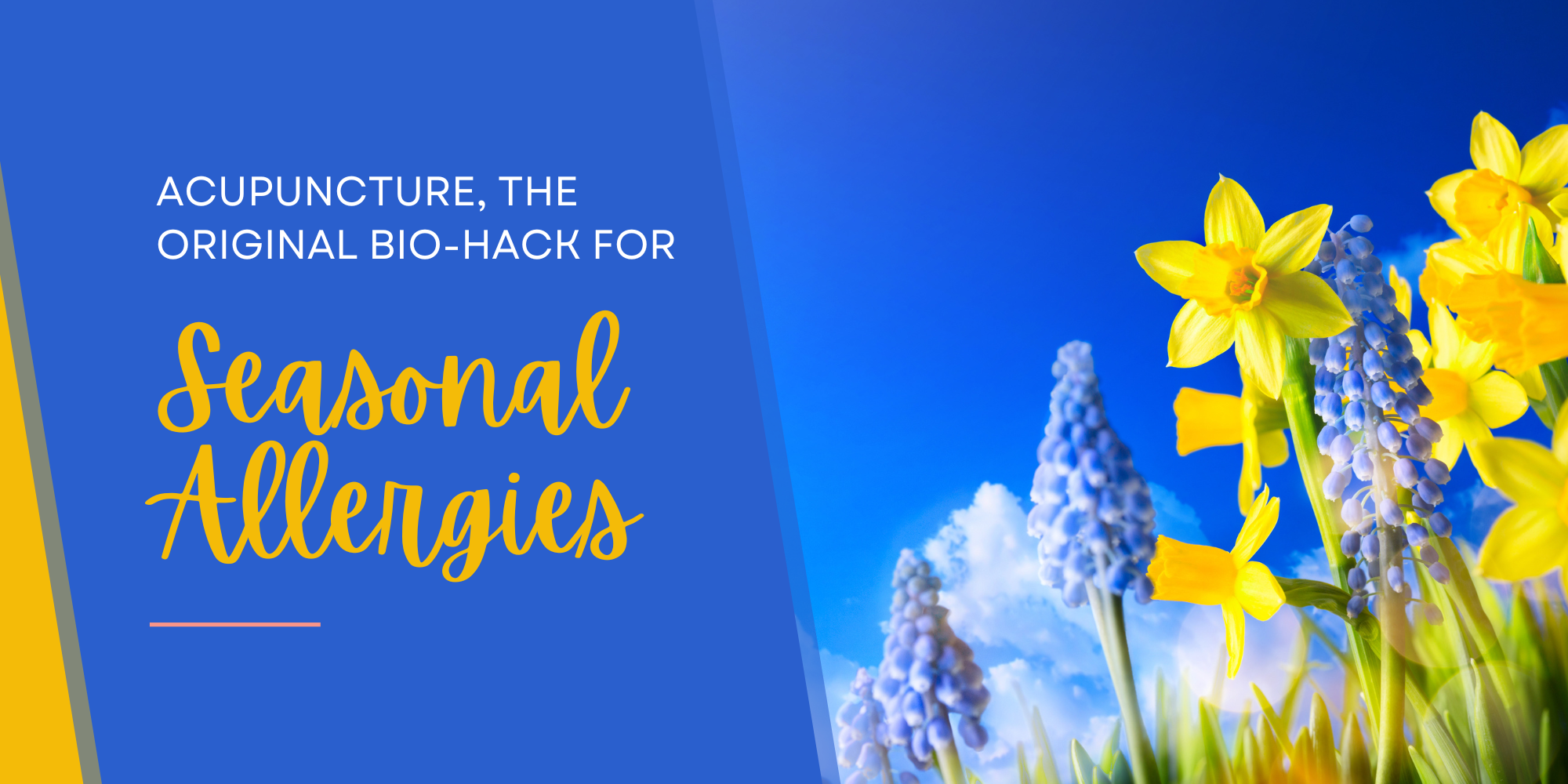
Many of us struggle with unpredictable seasonal-allergy symptoms. How does one create a plan of action to reduce the incidence and severity of an illness with such an unpredictable temperament? Luckily, acupuncture is like the duct tape of medical interventions, patching dysfunction and boosting the body’s natural resilience with the creative tenacity of MacGyver.
Acupuncture can often provide a measure of relief spanning several areas at once (stress relief, pain relief and immune system support at the same time). Because acupuncture’s mechanisms of action impact several biochemical pathways that influence seasonal allergies, it is a tool that works in both a preventive and a pain-relieving way. In this case, it treats nearly every stage of the seasonal allergy process (barring emergency medical conditions).
First stage: Annoyance and confusion. When did I start sniffling so much? Is my head hurting in general or just when I work? Am I getting weaker or is it actually more difficult to breathe? Is it [cedar/grass/mold etc.] season?
Acupuncture solution: Head it off at the pass! This is not a time to “tough it out” by ignoring these early warnings. This is a great time to come in for treatment. Acupuncture stimulates the immune system response, reduces stress, inflammation and alleviates symptoms such as runny nose, sneezing, itchy eyes and nose, nasal congestion and interrupted sleep due to all of the above (1). This creates the conditions for your body to stop the cycle of inflammation, creating a window of opportunity for the body to repair itself and avoid the deeper depths of the next phase.
Treatment plan suggestion: acupuncture twice a week for four to six weeks for optimal results.
Second stage: Desperation. Help! All of a sudden, my head/chest/throat/ sinuses are painful, inflamed, phlegm-sodden fonts of misery. Am I developing pneumonia? Am I now a public health hazard?
Acupuncture solution: Let an acupuncturist soothe your body and mind. This is a tricky time, when the couch or bed becomes magnetic and a box of tissues, tea and sleep are often prioritized over seeing a medical provider. There may also be concern that one has become infectious. Have no fear, acupuncturists are here to treat you at your most miserable and possibly infectious states. In the acute stage of allergy-induced illness, acupuncture can offer startlingly effective pain relief, reduce the proinflammatory neuropeptides and cytokines that are making mischief in the mucosal tissues, and help clear the nasal passages (1). It can help the storm pass more quickly and give you an hour of much-needed rest during the treatment itself. An acupuncturist can also confirm whether a visit to urgent care is needed in cases such as bacterial infection and severe respiratory distress.
Treatment plan suggestion: every two to three days for three visits during the acute phase, including herbal formula prescription and cupping.
Third-Fifth stages: Denial, Amnesia, and Accommodation. The storm may have passed, but the waters are still choppy. Living on steroidal inhalers and antihistamines can’t hurt, can it? Shall I mow the lawn and just assume that I will generally feel more tired and foggy headed for the next three months?
Acupuncture solution: This is the absolute best time to come in for acupuncture. Patch the roof when the sun is out, rather than when you’re reminded of the leaky roof in the middle of the storm. According to Chinese medical theory, one should treat seasonal diseases two seasons ahead. So if you have stronger symptoms in the spring and summer, start getting acupuncture weekly in the fall and winter. This helps diminish the severity and frequency of allergy symptoms during the high season, and your acupuncturist can also recommend things to do at home in the meantime to support your body’s immune system. Try using diet and herbs, lifestyle adjustments, acupressure self-massage and other tools for stress relief such as meditation, which has been shown to activate the anti-inflammatory and immune system response. Could this be the original form of biohacking?
Ultimately, acupuncture should be considered as a first-line treatment for the discomfort of acute seasonal allergies, a medical tool to prevent flare-ups of allergies, and as a source of biohack information using herbs, diet, meditation and self-massage to improve well-being year-round.
McDonald, J. et. al. Evidence-Based Complementary and Alternative Medicine. The Anti-Inflammatory Effects of Acupuncture and Their Relevance to Allergic Rhinitis: A Narrative Review and Proposed Model. Volume 2013 (2013), Article ID 591796, 12 pages
